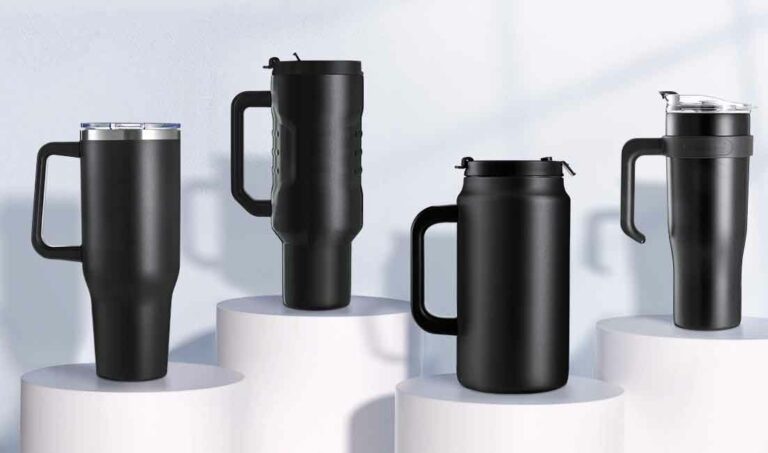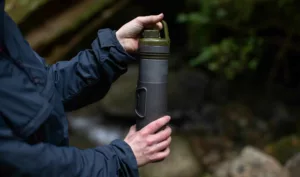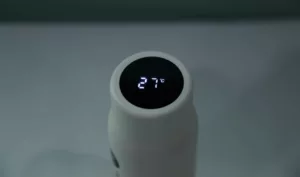Introduction
The short answer is no; microwaving a Yeti is not safe. Yeti drinkware, including mugs, tumblers, jugs, and bottles, is made from high-quality 18/8 stainless steel. Steel, like aluminum or any other conductive metal, does not mix well with radiation emitted by microwaves.
In this article, we will dig into the important safety elements about heating beverages in stainless steel water bottles, such as Yeti cups. These stylish drinkwares have become popular for their ability to keep liquids hot or cold for a long time. However, it is crucial to grasp the dos and don’ts of microwaving these containers to prevent potential hazards and maintain the quality of these favored bottles. Come along as we delve into the reasons behind the controversy, the associated risks, and the optimal practices to guarantee your safety when warming beverages in these widely used insulated bottles.
Why Can’t You Put Yeti Cups in the Microwave?
Yeti cups are not designed for use in the microwave due to their construction materials. Yeti cups are typically made from stainless steel, which is not microwave-safe. Microwaving stainless steel can cause sparks and potentially damage the microwave oven.
Additionally, Yeti cups often have double-wall insulation with a vacuum between the walls. Microwaving such insulated containers can create pressure between the walls, leading to deformation or damage to the cup. The vacuum insulation is designed to keep beverages at their desired temperature, but it may not withstand the conditions inside a microwave.
In summary, it is not recommended to put Yeti cups in the microwave because of the materials they are made from and the potential risks of damage to both the cup and the microwave. It’s always advisable to follow the manufacturer’s guidelines and warnings for the proper use of their products.
Can Yeti Contain Hot Water?
Yes, Yeti cups and tumblers are designed to handle hot liquids, including hot water. Yeti products are known for their excellent insulation capabilities, which work for both hot and cold beverages. The double-wall vacuum insulation helps keep hot drinks hot and cold drinks cold for an extended period.
Can You Put A Stainless Steel Cup In The Microwave?
Stainless steel cup can not be put into the microwave oven for heating. Because into the furnace iron, aluminum, stainless steel, enamel and other utensils, microwave heating will produce sparks and reflect microwave, both damage to the furnace and can not heat the food.
Heating liquids should be used wide-mouth containers, because the heat generated by the heating of food in closed containers is not easy to disseminate, so that the pressure inside the container is too high, easy to cause blasting accidents.
Microwave encounter metal will be reflected back, so the use of specially treated steel plate made of the inner wall, according to the microwave oven wall caused by the reflection effect, so that microwaves back and forth to penetrate the food, to strengthen the thermal efficiency. However, the furnace must not use metal containers, otherwise it will affect the heating time, and even cause the furnace discharge fire.
Generally speaking, thermos cups are usually not recommended to be heated in the microwave oven. Thermos cups are usually made of different materials, including materials that are not suitable for microwave heating, such as opaque metal, aluminum foil, vacuum layer, etc.. Heating these materials in the microwave may cause the mug to be damaged, deformed, or even cause a fire.
In addition, thermos cups may contain seals, insulation, or other attachments, and these parts may also be unsuitable for microwave heating. The heat generated by the microwave may cause damage to these parts.
If you need to heat liquids or food, it is recommended that you use microwave-safe containers or utensils designed for microwave ovens. Before using any utensil, it is a good idea to check the instructions provided by the manufacturer to ensure that it is suitable for microwave heating. If you are unsure if a utensil is suitable for microwave use, it is best to avoid placing it in the microwave to prevent safety issues.
Can You Microwave A Plastic Cup?
Microwave heating requires the use of specific microwave-transparent materials because many plastic containers can melt at high temperatures or release harmful substances, so plastic containers must be chosen very carefully. Here are some of the types of plastic containers that can be used for microwave heating:
Polypropylene (PP): polypropylene is a common plastic material that is often used to make microwave-safe containers. It can hold its shape at high temperatures without melting or releasing harmful substances. Many microwave food containers and plastic utensils are made from polypropylene.
High-density polyethylene (HDPE): HDPE is another common microwave-safe material. This plastic water bottle is usually white or opaque and is commonly used for baby food or other liquid or semi-solid foods.
Polyethylene (PE): Polyethylene is a softer plastic material that is often used to make frozen food bags or microwaveable bags. Unlike polypropylene and HDPE, polyethylene may deform at high temperatures and must be used with care. Please note that even plastic containers labeled as microwave safe should be used with caution. Always check the label and any instructions for use on the container before use to ensure it is safe for microwave heating.
Conclusion
In conclusion, microwaving Hydro Flasks and Yeti Cups is not safe due to their stainless-steel construction, which can cause sparking, fires, and damage to both the containers and the microwave. It is best to avoid microwaving any metal containers, including these popular insulated bottles made by Yeti manufacturer, to prevent potential hazards and maintain their insulation properties. Instead, opt for microwave-safe containers made of glass or ceramic when heating beverages. Safety tips, such as using heat-resistant mitts, being cautious with hot liquids, and allowing beverages to cool before consumption, should always be followed to avoid accidents and burns. Properly caring for Yeti Cups and Hydro Flasks, such as handwashing, regular maintenance, and avoiding extreme temperature changes, ensures their longevity and optimal performance. By prioritizing safety and following best practices, you can enjoy your favorite drinks with confidence and convenience. If you want more information, please contact us!
In summary, microwaving Yeti bottles is not safe because they are made of stainless steel materials, which can result in sparking, fires, and damage to the water containers and the microwave.




